MKTG 1000 Assignment: Segmentation, Labeling, and Marketing Factors
VerifiedAdded on 2022/07/29
|12
|3173
|18
Homework Assignment
AI Summary
This assignment analyzes marketing concepts, focusing on market segmentation and organic labeling. It explores segmentation strategies employed by OPTUS, including demographic, geographic, and psychographic approaches, explaining how these strategies target specific customer groups. The assignment also discusses the concept of organic labeling and how external marketing factors, such as culture and social class, influence consumer perception and purchasing decisions. The solution includes detailed explanations and examples to illustrate the application of marketing principles in a real-world business context, providing a comprehensive understanding of marketing strategies and their impact on consumer behavior. The assignment offers insights into how businesses can effectively segment their markets and tailor their marketing efforts to meet the diverse needs and preferences of their target audiences.
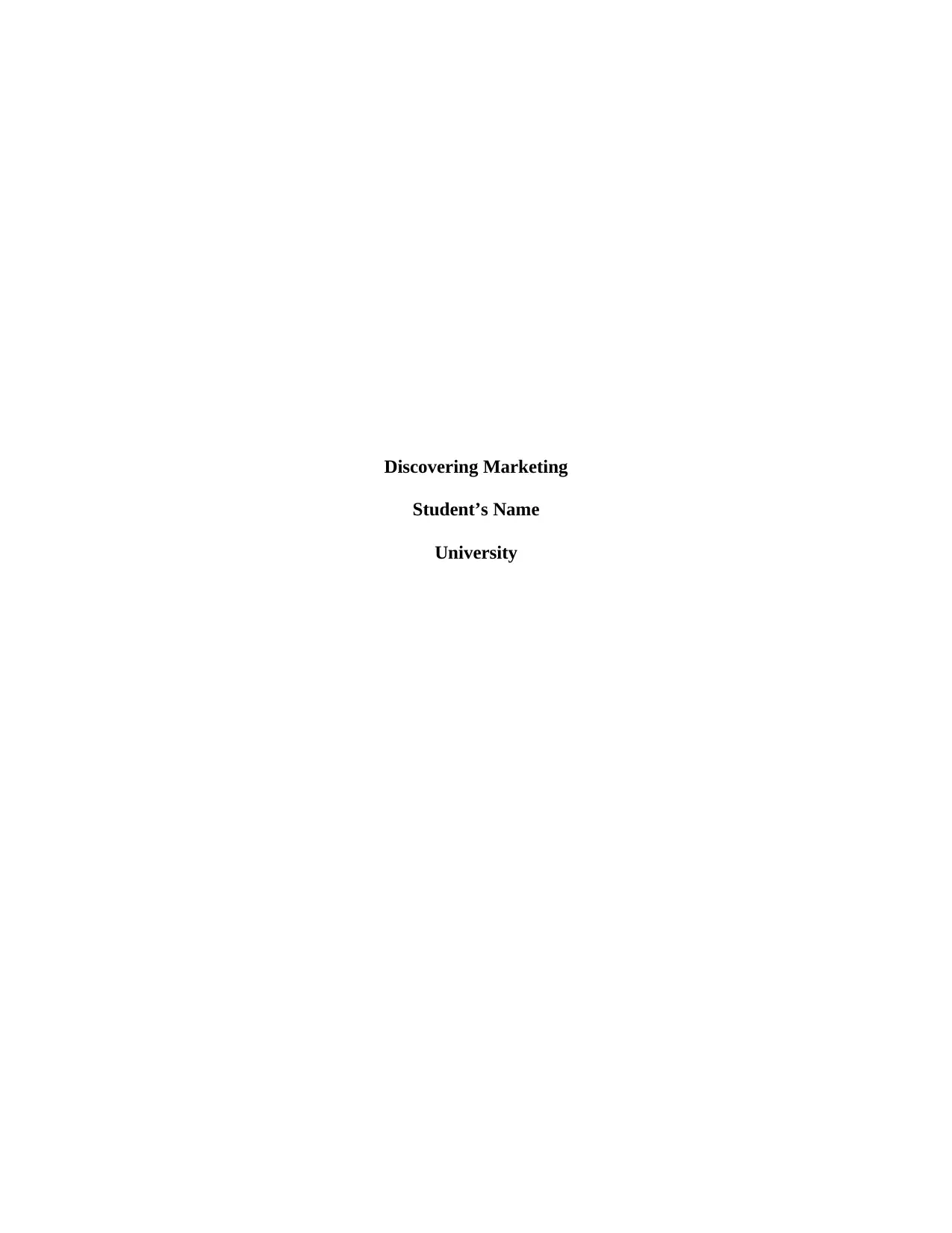
Discovering Marketing
Student’s Name
University
Student’s Name
University
Paraphrase This Document
Need a fresh take? Get an instant paraphrase of this document with our AI Paraphraser
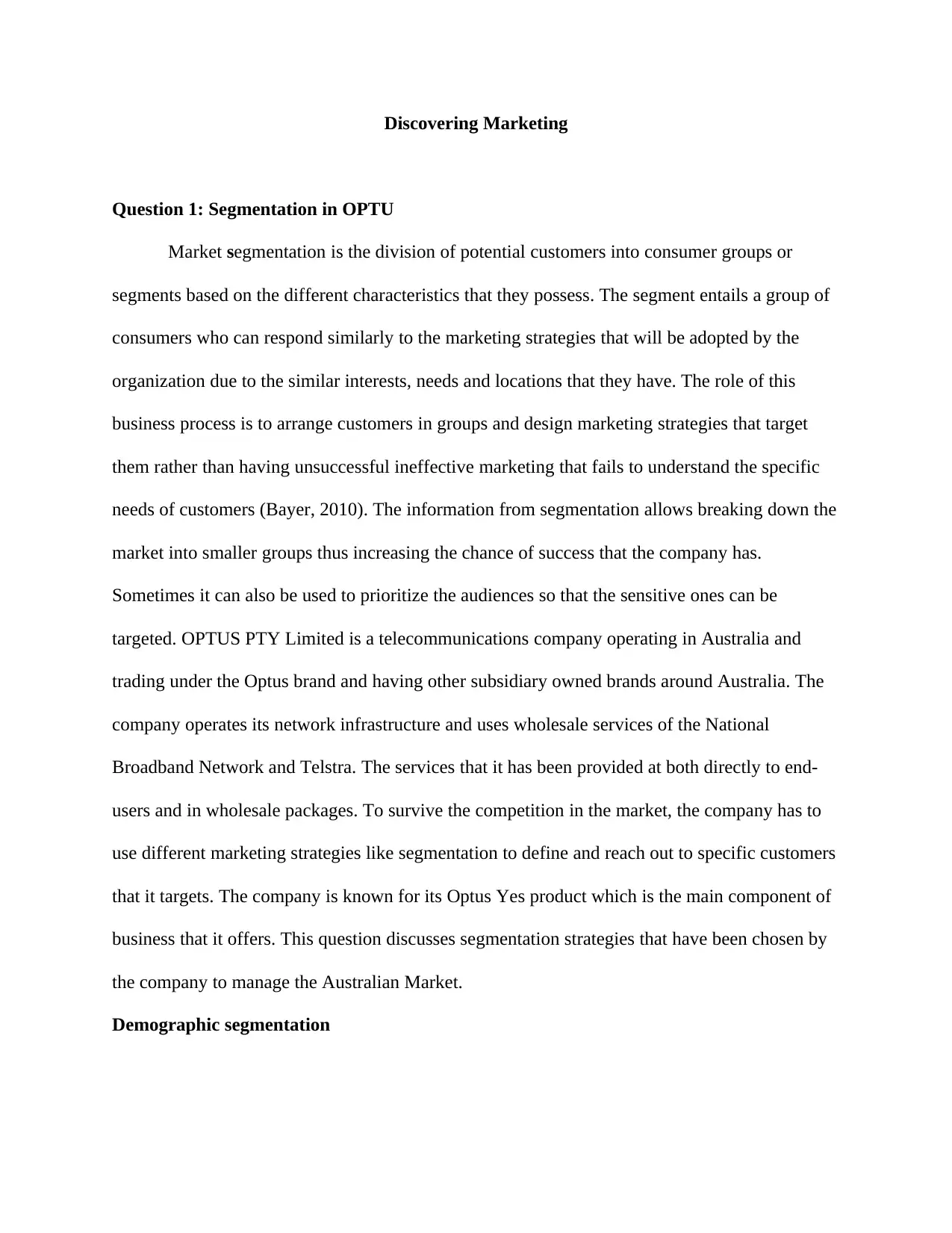
Discovering Marketing
Question 1: Segmentation in OPTU
Market segmentation is the division of potential customers into consumer groups or
segments based on the different characteristics that they possess. The segment entails a group of
consumers who can respond similarly to the marketing strategies that will be adopted by the
organization due to the similar interests, needs and locations that they have. The role of this
business process is to arrange customers in groups and design marketing strategies that target
them rather than having unsuccessful ineffective marketing that fails to understand the specific
needs of customers (Bayer, 2010). The information from segmentation allows breaking down the
market into smaller groups thus increasing the chance of success that the company has.
Sometimes it can also be used to prioritize the audiences so that the sensitive ones can be
targeted. OPTUS PTY Limited is a telecommunications company operating in Australia and
trading under the Optus brand and having other subsidiary owned brands around Australia. The
company operates its network infrastructure and uses wholesale services of the National
Broadband Network and Telstra. The services that it has been provided at both directly to end-
users and in wholesale packages. To survive the competition in the market, the company has to
use different marketing strategies like segmentation to define and reach out to specific customers
that it targets. The company is known for its Optus Yes product which is the main component of
business that it offers. This question discusses segmentation strategies that have been chosen by
the company to manage the Australian Market.
Demographic segmentation
Question 1: Segmentation in OPTU
Market segmentation is the division of potential customers into consumer groups or
segments based on the different characteristics that they possess. The segment entails a group of
consumers who can respond similarly to the marketing strategies that will be adopted by the
organization due to the similar interests, needs and locations that they have. The role of this
business process is to arrange customers in groups and design marketing strategies that target
them rather than having unsuccessful ineffective marketing that fails to understand the specific
needs of customers (Bayer, 2010). The information from segmentation allows breaking down the
market into smaller groups thus increasing the chance of success that the company has.
Sometimes it can also be used to prioritize the audiences so that the sensitive ones can be
targeted. OPTUS PTY Limited is a telecommunications company operating in Australia and
trading under the Optus brand and having other subsidiary owned brands around Australia. The
company operates its network infrastructure and uses wholesale services of the National
Broadband Network and Telstra. The services that it has been provided at both directly to end-
users and in wholesale packages. To survive the competition in the market, the company has to
use different marketing strategies like segmentation to define and reach out to specific customers
that it targets. The company is known for its Optus Yes product which is the main component of
business that it offers. This question discusses segmentation strategies that have been chosen by
the company to manage the Australian Market.
Demographic segmentation
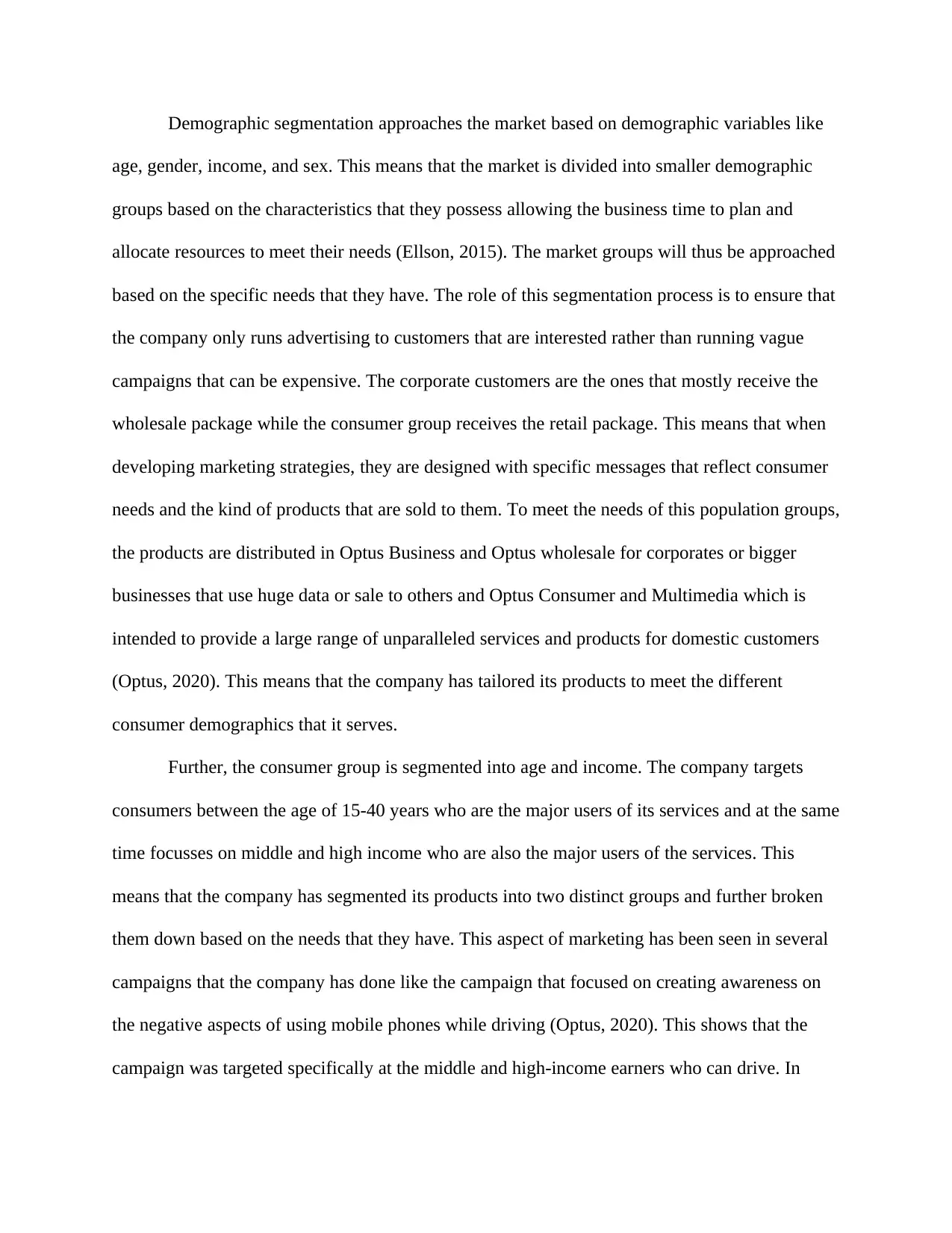
Demographic segmentation approaches the market based on demographic variables like
age, gender, income, and sex. This means that the market is divided into smaller demographic
groups based on the characteristics that they possess allowing the business time to plan and
allocate resources to meet their needs (Ellson, 2015). The market groups will thus be approached
based on the specific needs that they have. The role of this segmentation process is to ensure that
the company only runs advertising to customers that are interested rather than running vague
campaigns that can be expensive. The corporate customers are the ones that mostly receive the
wholesale package while the consumer group receives the retail package. This means that when
developing marketing strategies, they are designed with specific messages that reflect consumer
needs and the kind of products that are sold to them. To meet the needs of this population groups,
the products are distributed in Optus Business and Optus wholesale for corporates or bigger
businesses that use huge data or sale to others and Optus Consumer and Multimedia which is
intended to provide a large range of unparalleled services and products for domestic customers
(Optus, 2020). This means that the company has tailored its products to meet the different
consumer demographics that it serves.
Further, the consumer group is segmented into age and income. The company targets
consumers between the age of 15-40 years who are the major users of its services and at the same
time focusses on middle and high income who are also the major users of the services. This
means that the company has segmented its products into two distinct groups and further broken
them down based on the needs that they have. This aspect of marketing has been seen in several
campaigns that the company has done like the campaign that focused on creating awareness on
the negative aspects of using mobile phones while driving (Optus, 2020). This shows that the
campaign was targeted specifically at the middle and high-income earners who can drive. In
age, gender, income, and sex. This means that the market is divided into smaller demographic
groups based on the characteristics that they possess allowing the business time to plan and
allocate resources to meet their needs (Ellson, 2015). The market groups will thus be approached
based on the specific needs that they have. The role of this segmentation process is to ensure that
the company only runs advertising to customers that are interested rather than running vague
campaigns that can be expensive. The corporate customers are the ones that mostly receive the
wholesale package while the consumer group receives the retail package. This means that when
developing marketing strategies, they are designed with specific messages that reflect consumer
needs and the kind of products that are sold to them. To meet the needs of this population groups,
the products are distributed in Optus Business and Optus wholesale for corporates or bigger
businesses that use huge data or sale to others and Optus Consumer and Multimedia which is
intended to provide a large range of unparalleled services and products for domestic customers
(Optus, 2020). This means that the company has tailored its products to meet the different
consumer demographics that it serves.
Further, the consumer group is segmented into age and income. The company targets
consumers between the age of 15-40 years who are the major users of its services and at the same
time focusses on middle and high income who are also the major users of the services. This
means that the company has segmented its products into two distinct groups and further broken
them down based on the needs that they have. This aspect of marketing has been seen in several
campaigns that the company has done like the campaign that focused on creating awareness on
the negative aspects of using mobile phones while driving (Optus, 2020). This shows that the
campaign was targeted specifically at the middle and high-income earners who can drive. In
⊘ This is a preview!⊘
Do you want full access?
Subscribe today to unlock all pages.

Trusted by 1+ million students worldwide
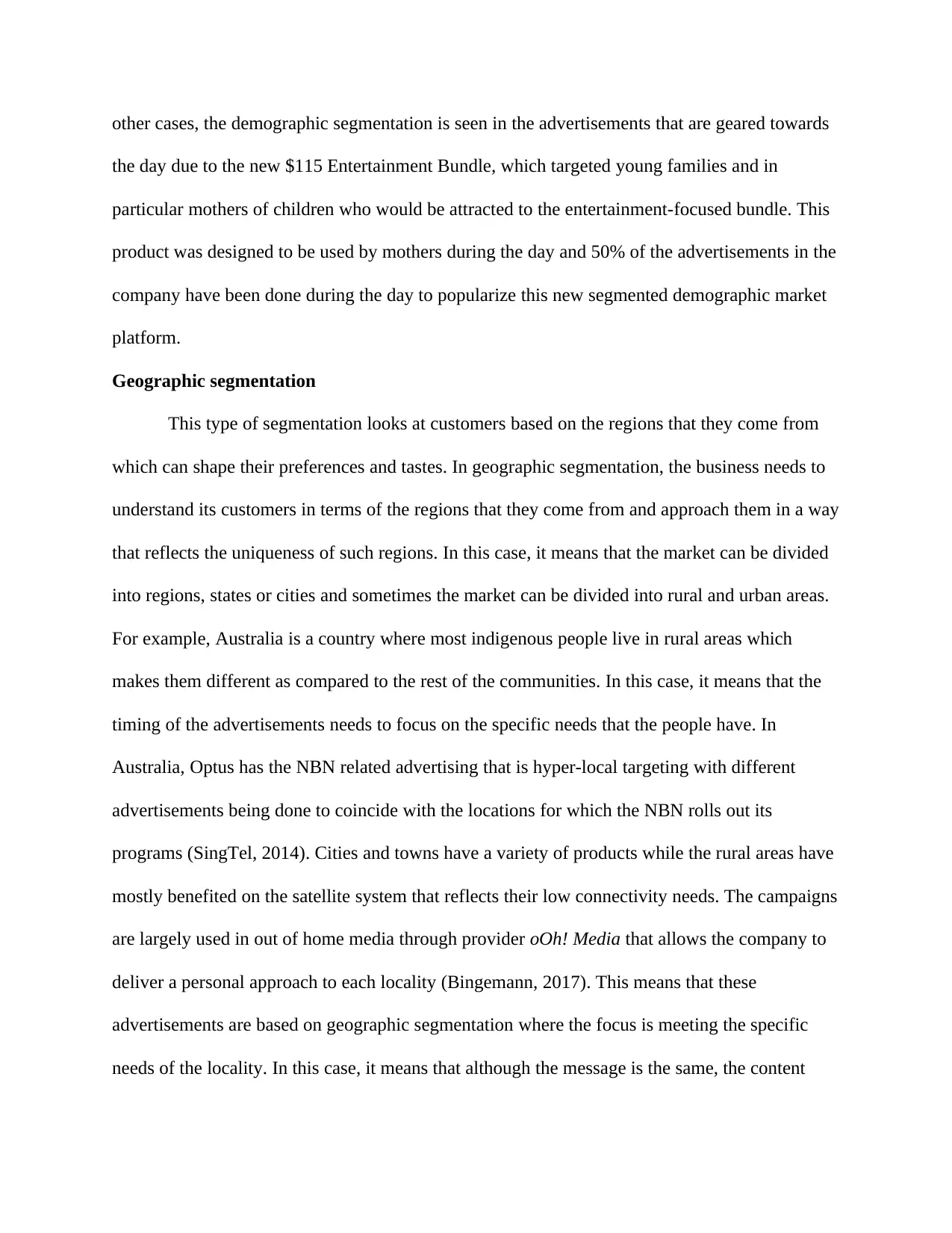
other cases, the demographic segmentation is seen in the advertisements that are geared towards
the day due to the new $115 Entertainment Bundle, which targeted young families and in
particular mothers of children who would be attracted to the entertainment-focused bundle. This
product was designed to be used by mothers during the day and 50% of the advertisements in the
company have been done during the day to popularize this new segmented demographic market
platform.
Geographic segmentation
This type of segmentation looks at customers based on the regions that they come from
which can shape their preferences and tastes. In geographic segmentation, the business needs to
understand its customers in terms of the regions that they come from and approach them in a way
that reflects the uniqueness of such regions. In this case, it means that the market can be divided
into regions, states or cities and sometimes the market can be divided into rural and urban areas.
For example, Australia is a country where most indigenous people live in rural areas which
makes them different as compared to the rest of the communities. In this case, it means that the
timing of the advertisements needs to focus on the specific needs that the people have. In
Australia, Optus has the NBN related advertising that is hyper-local targeting with different
advertisements being done to coincide with the locations for which the NBN rolls out its
programs (SingTel, 2014). Cities and towns have a variety of products while the rural areas have
mostly benefited on the satellite system that reflects their low connectivity needs. The campaigns
are largely used in out of home media through provider oOh! Media that allows the company to
deliver a personal approach to each locality (Bingemann, 2017). This means that these
advertisements are based on geographic segmentation where the focus is meeting the specific
needs of the locality. In this case, it means that although the message is the same, the content
the day due to the new $115 Entertainment Bundle, which targeted young families and in
particular mothers of children who would be attracted to the entertainment-focused bundle. This
product was designed to be used by mothers during the day and 50% of the advertisements in the
company have been done during the day to popularize this new segmented demographic market
platform.
Geographic segmentation
This type of segmentation looks at customers based on the regions that they come from
which can shape their preferences and tastes. In geographic segmentation, the business needs to
understand its customers in terms of the regions that they come from and approach them in a way
that reflects the uniqueness of such regions. In this case, it means that the market can be divided
into regions, states or cities and sometimes the market can be divided into rural and urban areas.
For example, Australia is a country where most indigenous people live in rural areas which
makes them different as compared to the rest of the communities. In this case, it means that the
timing of the advertisements needs to focus on the specific needs that the people have. In
Australia, Optus has the NBN related advertising that is hyper-local targeting with different
advertisements being done to coincide with the locations for which the NBN rolls out its
programs (SingTel, 2014). Cities and towns have a variety of products while the rural areas have
mostly benefited on the satellite system that reflects their low connectivity needs. The campaigns
are largely used in out of home media through provider oOh! Media that allows the company to
deliver a personal approach to each locality (Bingemann, 2017). This means that these
advertisements are based on geographic segmentation where the focus is meeting the specific
needs of the locality. In this case, it means that although the message is the same, the content
Paraphrase This Document
Need a fresh take? Get an instant paraphrase of this document with our AI Paraphraser
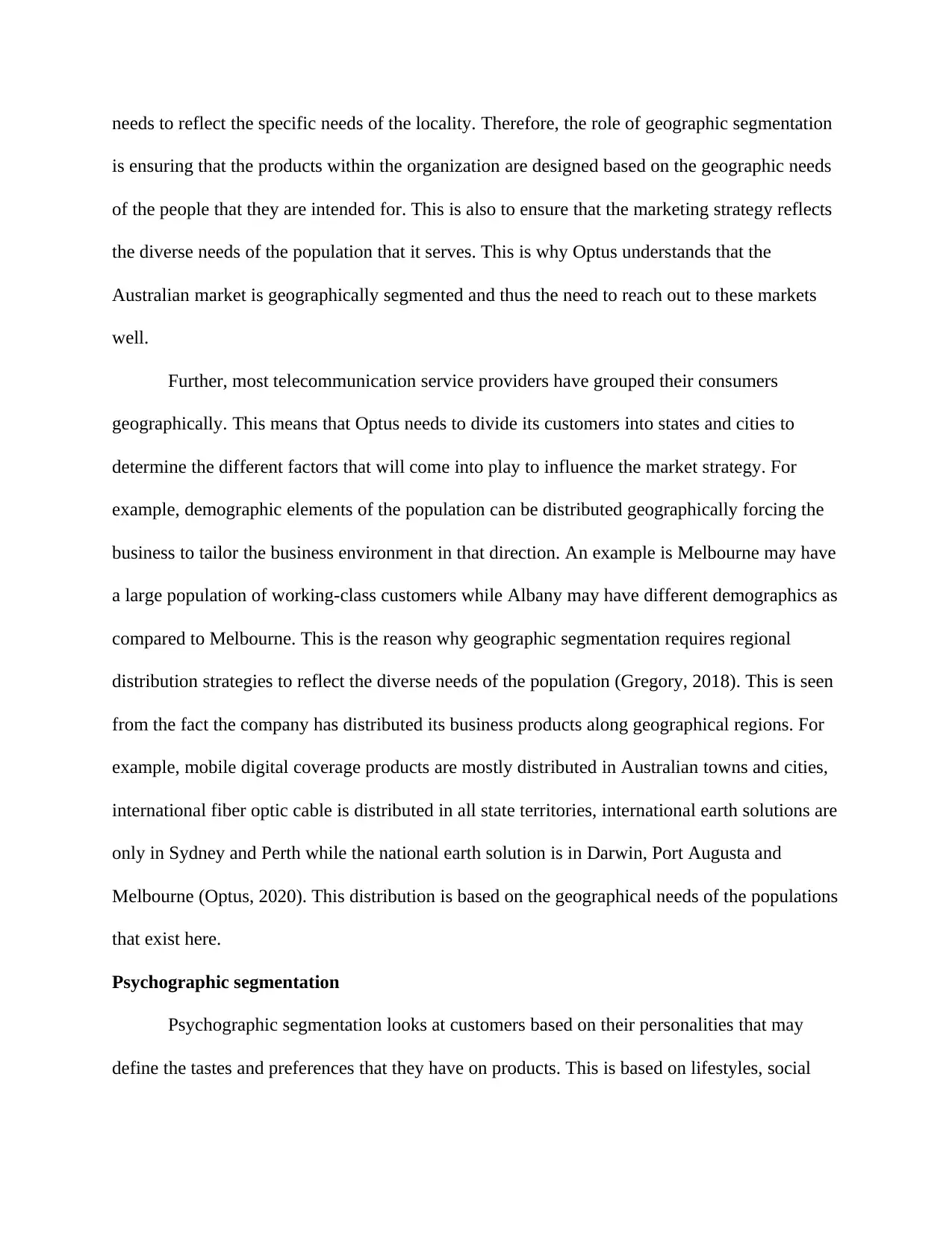
needs to reflect the specific needs of the locality. Therefore, the role of geographic segmentation
is ensuring that the products within the organization are designed based on the geographic needs
of the people that they are intended for. This is also to ensure that the marketing strategy reflects
the diverse needs of the population that it serves. This is why Optus understands that the
Australian market is geographically segmented and thus the need to reach out to these markets
well.
Further, most telecommunication service providers have grouped their consumers
geographically. This means that Optus needs to divide its customers into states and cities to
determine the different factors that will come into play to influence the market strategy. For
example, demographic elements of the population can be distributed geographically forcing the
business to tailor the business environment in that direction. An example is Melbourne may have
a large population of working-class customers while Albany may have different demographics as
compared to Melbourne. This is the reason why geographic segmentation requires regional
distribution strategies to reflect the diverse needs of the population (Gregory, 2018). This is seen
from the fact the company has distributed its business products along geographical regions. For
example, mobile digital coverage products are mostly distributed in Australian towns and cities,
international fiber optic cable is distributed in all state territories, international earth solutions are
only in Sydney and Perth while the national earth solution is in Darwin, Port Augusta and
Melbourne (Optus, 2020). This distribution is based on the geographical needs of the populations
that exist here.
Psychographic segmentation
Psychographic segmentation looks at customers based on their personalities that may
define the tastes and preferences that they have on products. This is based on lifestyles, social
is ensuring that the products within the organization are designed based on the geographic needs
of the people that they are intended for. This is also to ensure that the marketing strategy reflects
the diverse needs of the population that it serves. This is why Optus understands that the
Australian market is geographically segmented and thus the need to reach out to these markets
well.
Further, most telecommunication service providers have grouped their consumers
geographically. This means that Optus needs to divide its customers into states and cities to
determine the different factors that will come into play to influence the market strategy. For
example, demographic elements of the population can be distributed geographically forcing the
business to tailor the business environment in that direction. An example is Melbourne may have
a large population of working-class customers while Albany may have different demographics as
compared to Melbourne. This is the reason why geographic segmentation requires regional
distribution strategies to reflect the diverse needs of the population (Gregory, 2018). This is seen
from the fact the company has distributed its business products along geographical regions. For
example, mobile digital coverage products are mostly distributed in Australian towns and cities,
international fiber optic cable is distributed in all state territories, international earth solutions are
only in Sydney and Perth while the national earth solution is in Darwin, Port Augusta and
Melbourne (Optus, 2020). This distribution is based on the geographical needs of the populations
that exist here.
Psychographic segmentation
Psychographic segmentation looks at customers based on their personalities that may
define the tastes and preferences that they have on products. This is based on lifestyles, social
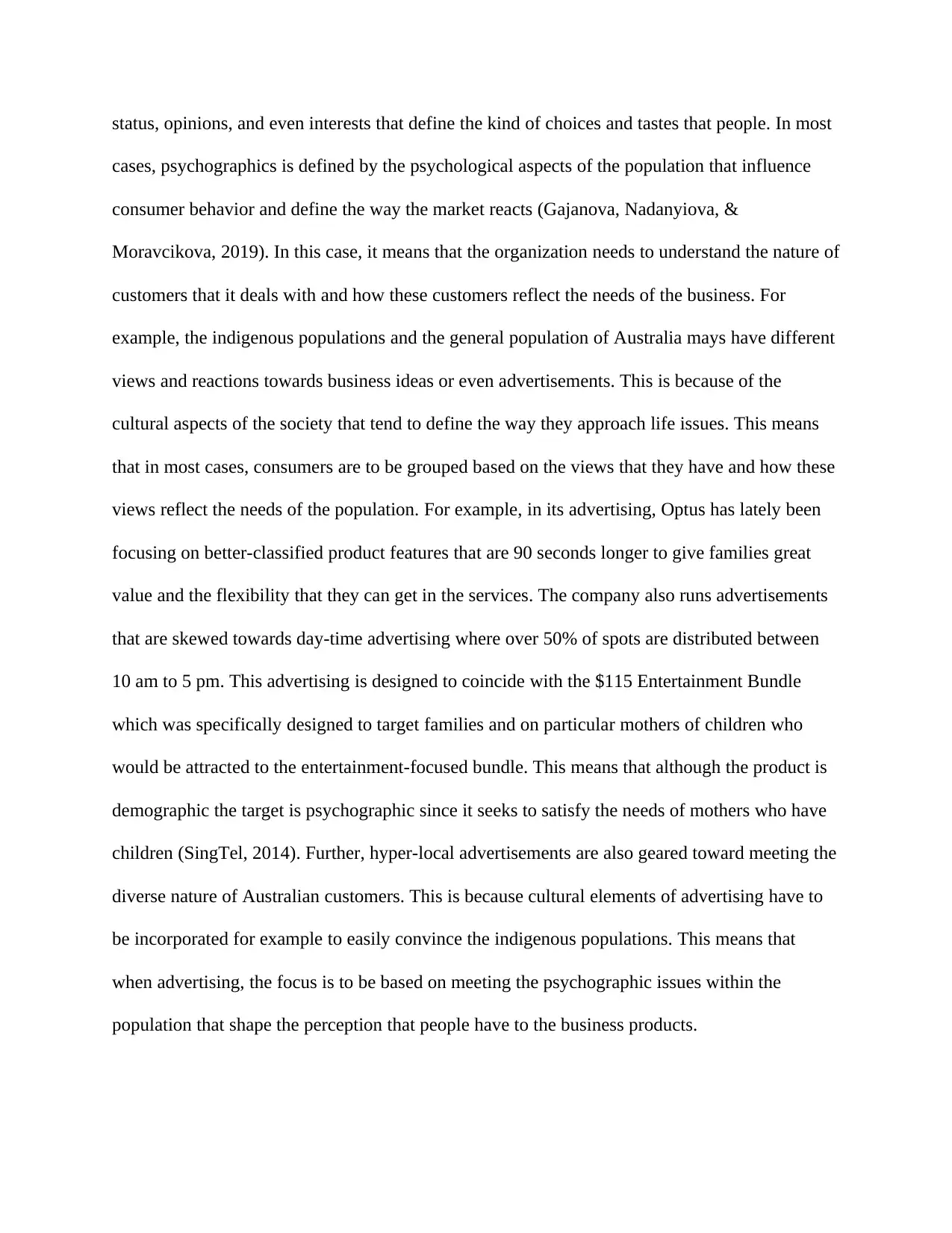
status, opinions, and even interests that define the kind of choices and tastes that people. In most
cases, psychographics is defined by the psychological aspects of the population that influence
consumer behavior and define the way the market reacts (Gajanova, Nadanyiova, &
Moravcikova, 2019). In this case, it means that the organization needs to understand the nature of
customers that it deals with and how these customers reflect the needs of the business. For
example, the indigenous populations and the general population of Australia mays have different
views and reactions towards business ideas or even advertisements. This is because of the
cultural aspects of the society that tend to define the way they approach life issues. This means
that in most cases, consumers are to be grouped based on the views that they have and how these
views reflect the needs of the population. For example, in its advertising, Optus has lately been
focusing on better-classified product features that are 90 seconds longer to give families great
value and the flexibility that they can get in the services. The company also runs advertisements
that are skewed towards day-time advertising where over 50% of spots are distributed between
10 am to 5 pm. This advertising is designed to coincide with the $115 Entertainment Bundle
which was specifically designed to target families and on particular mothers of children who
would be attracted to the entertainment-focused bundle. This means that although the product is
demographic the target is psychographic since it seeks to satisfy the needs of mothers who have
children (SingTel, 2014). Further, hyper-local advertisements are also geared toward meeting the
diverse nature of Australian customers. This is because cultural elements of advertising have to
be incorporated for example to easily convince the indigenous populations. This means that
when advertising, the focus is to be based on meeting the psychographic issues within the
population that shape the perception that people have to the business products.
cases, psychographics is defined by the psychological aspects of the population that influence
consumer behavior and define the way the market reacts (Gajanova, Nadanyiova, &
Moravcikova, 2019). In this case, it means that the organization needs to understand the nature of
customers that it deals with and how these customers reflect the needs of the business. For
example, the indigenous populations and the general population of Australia mays have different
views and reactions towards business ideas or even advertisements. This is because of the
cultural aspects of the society that tend to define the way they approach life issues. This means
that in most cases, consumers are to be grouped based on the views that they have and how these
views reflect the needs of the population. For example, in its advertising, Optus has lately been
focusing on better-classified product features that are 90 seconds longer to give families great
value and the flexibility that they can get in the services. The company also runs advertisements
that are skewed towards day-time advertising where over 50% of spots are distributed between
10 am to 5 pm. This advertising is designed to coincide with the $115 Entertainment Bundle
which was specifically designed to target families and on particular mothers of children who
would be attracted to the entertainment-focused bundle. This means that although the product is
demographic the target is psychographic since it seeks to satisfy the needs of mothers who have
children (SingTel, 2014). Further, hyper-local advertisements are also geared toward meeting the
diverse nature of Australian customers. This is because cultural elements of advertising have to
be incorporated for example to easily convince the indigenous populations. This means that
when advertising, the focus is to be based on meeting the psychographic issues within the
population that shape the perception that people have to the business products.
⊘ This is a preview!⊘
Do you want full access?
Subscribe today to unlock all pages.

Trusted by 1+ million students worldwide
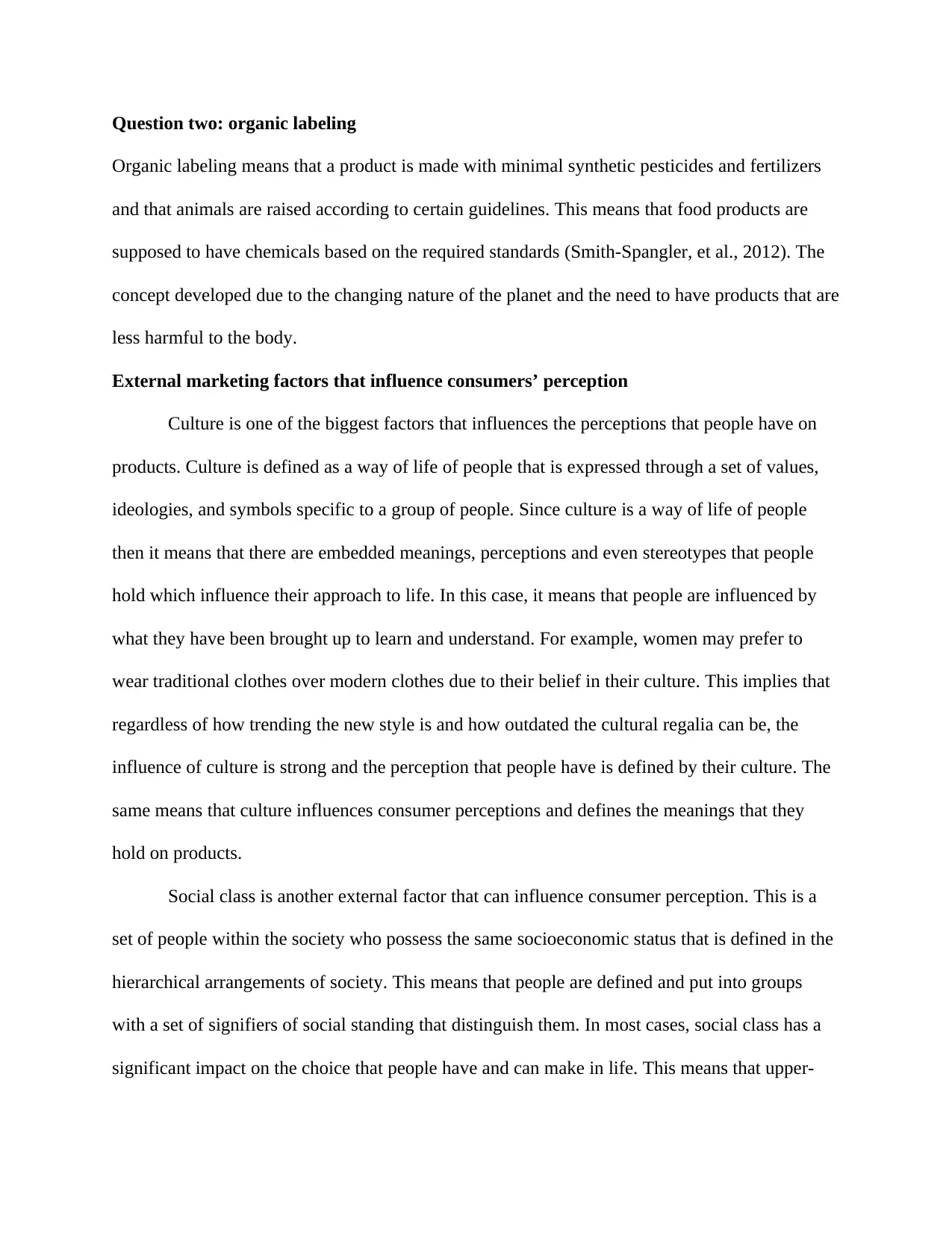
Question two: organic labeling
Organic labeling means that a product is made with minimal synthetic pesticides and fertilizers
and that animals are raised according to certain guidelines. This means that food products are
supposed to have chemicals based on the required standards (Smith-Spangler, et al., 2012). The
concept developed due to the changing nature of the planet and the need to have products that are
less harmful to the body.
External marketing factors that influence consumers’ perception
Culture is one of the biggest factors that influences the perceptions that people have on
products. Culture is defined as a way of life of people that is expressed through a set of values,
ideologies, and symbols specific to a group of people. Since culture is a way of life of people
then it means that there are embedded meanings, perceptions and even stereotypes that people
hold which influence their approach to life. In this case, it means that people are influenced by
what they have been brought up to learn and understand. For example, women may prefer to
wear traditional clothes over modern clothes due to their belief in their culture. This implies that
regardless of how trending the new style is and how outdated the cultural regalia can be, the
influence of culture is strong and the perception that people have is defined by their culture. The
same means that culture influences consumer perceptions and defines the meanings that they
hold on products.
Social class is another external factor that can influence consumer perception. This is a
set of people within the society who possess the same socioeconomic status that is defined in the
hierarchical arrangements of society. This means that people are defined and put into groups
with a set of signifiers of social standing that distinguish them. In most cases, social class has a
significant impact on the choice that people have and can make in life. This means that upper-
Organic labeling means that a product is made with minimal synthetic pesticides and fertilizers
and that animals are raised according to certain guidelines. This means that food products are
supposed to have chemicals based on the required standards (Smith-Spangler, et al., 2012). The
concept developed due to the changing nature of the planet and the need to have products that are
less harmful to the body.
External marketing factors that influence consumers’ perception
Culture is one of the biggest factors that influences the perceptions that people have on
products. Culture is defined as a way of life of people that is expressed through a set of values,
ideologies, and symbols specific to a group of people. Since culture is a way of life of people
then it means that there are embedded meanings, perceptions and even stereotypes that people
hold which influence their approach to life. In this case, it means that people are influenced by
what they have been brought up to learn and understand. For example, women may prefer to
wear traditional clothes over modern clothes due to their belief in their culture. This implies that
regardless of how trending the new style is and how outdated the cultural regalia can be, the
influence of culture is strong and the perception that people have is defined by their culture. The
same means that culture influences consumer perceptions and defines the meanings that they
hold on products.
Social class is another external factor that can influence consumer perception. This is a
set of people within the society who possess the same socioeconomic status that is defined in the
hierarchical arrangements of society. This means that people are defined and put into groups
with a set of signifiers of social standing that distinguish them. In most cases, social class has a
significant impact on the choice that people have and can make in life. This means that upper-
Paraphrase This Document
Need a fresh take? Get an instant paraphrase of this document with our AI Paraphraser
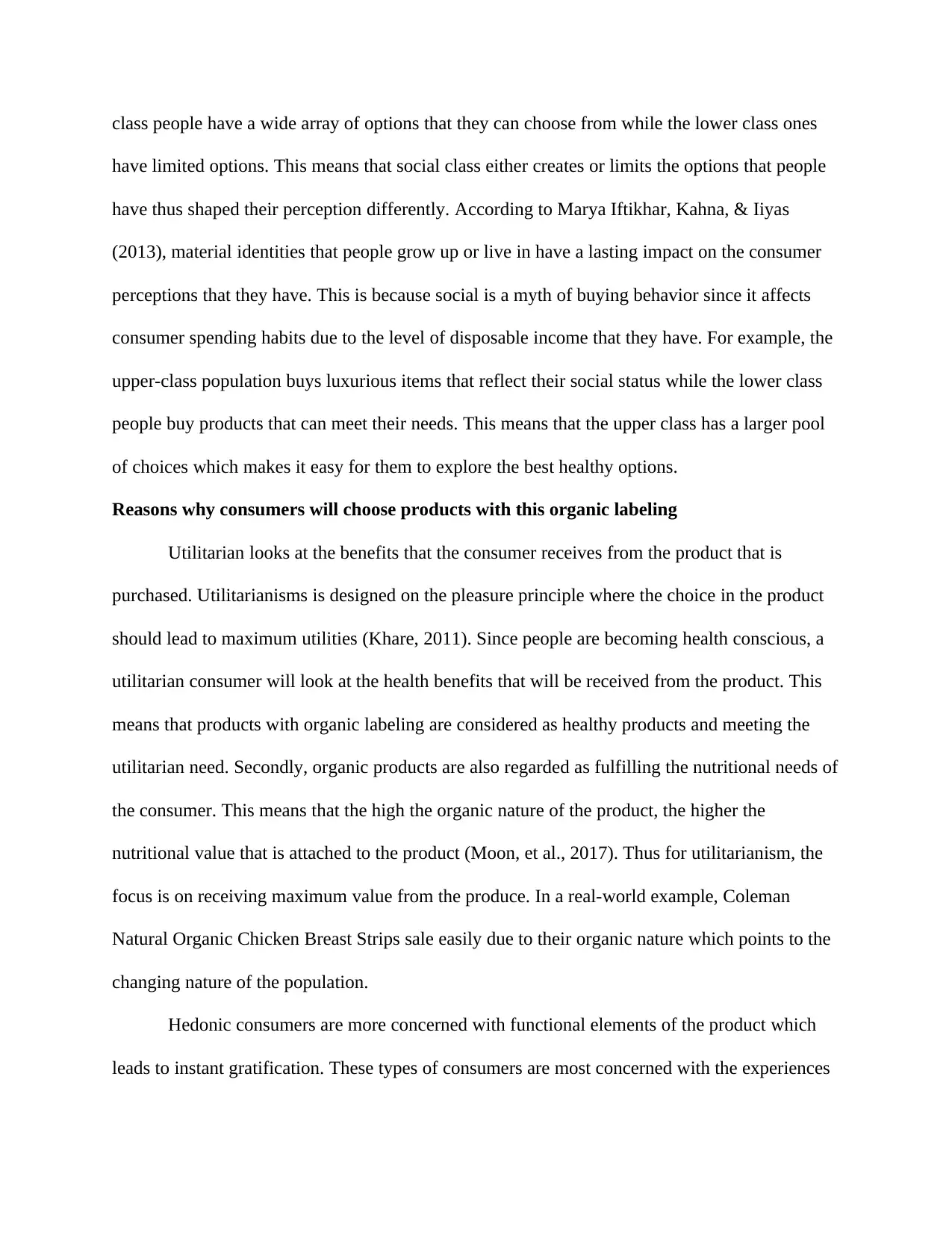
class people have a wide array of options that they can choose from while the lower class ones
have limited options. This means that social class either creates or limits the options that people
have thus shaped their perception differently. According to Marya Iftikhar, Kahna, & Iiyas
(2013), material identities that people grow up or live in have a lasting impact on the consumer
perceptions that they have. This is because social is a myth of buying behavior since it affects
consumer spending habits due to the level of disposable income that they have. For example, the
upper-class population buys luxurious items that reflect their social status while the lower class
people buy products that can meet their needs. This means that the upper class has a larger pool
of choices which makes it easy for them to explore the best healthy options.
Reasons why consumers will choose products with this organic labeling
Utilitarian looks at the benefits that the consumer receives from the product that is
purchased. Utilitarianisms is designed on the pleasure principle where the choice in the product
should lead to maximum utilities (Khare, 2011). Since people are becoming health conscious, a
utilitarian consumer will look at the health benefits that will be received from the product. This
means that products with organic labeling are considered as healthy products and meeting the
utilitarian need. Secondly, organic products are also regarded as fulfilling the nutritional needs of
the consumer. This means that the high the organic nature of the product, the higher the
nutritional value that is attached to the product (Moon, et al., 2017). Thus for utilitarianism, the
focus is on receiving maximum value from the produce. In a real-world example, Coleman
Natural Organic Chicken Breast Strips sale easily due to their organic nature which points to the
changing nature of the population.
Hedonic consumers are more concerned with functional elements of the product which
leads to instant gratification. These types of consumers are most concerned with the experiences
have limited options. This means that social class either creates or limits the options that people
have thus shaped their perception differently. According to Marya Iftikhar, Kahna, & Iiyas
(2013), material identities that people grow up or live in have a lasting impact on the consumer
perceptions that they have. This is because social is a myth of buying behavior since it affects
consumer spending habits due to the level of disposable income that they have. For example, the
upper-class population buys luxurious items that reflect their social status while the lower class
people buy products that can meet their needs. This means that the upper class has a larger pool
of choices which makes it easy for them to explore the best healthy options.
Reasons why consumers will choose products with this organic labeling
Utilitarian looks at the benefits that the consumer receives from the product that is
purchased. Utilitarianisms is designed on the pleasure principle where the choice in the product
should lead to maximum utilities (Khare, 2011). Since people are becoming health conscious, a
utilitarian consumer will look at the health benefits that will be received from the product. This
means that products with organic labeling are considered as healthy products and meeting the
utilitarian need. Secondly, organic products are also regarded as fulfilling the nutritional needs of
the consumer. This means that the high the organic nature of the product, the higher the
nutritional value that is attached to the product (Moon, et al., 2017). Thus for utilitarianism, the
focus is on receiving maximum value from the produce. In a real-world example, Coleman
Natural Organic Chicken Breast Strips sale easily due to their organic nature which points to the
changing nature of the population.
Hedonic consumers are more concerned with functional elements of the product which
leads to instant gratification. These types of consumers are most concerned with the experiences
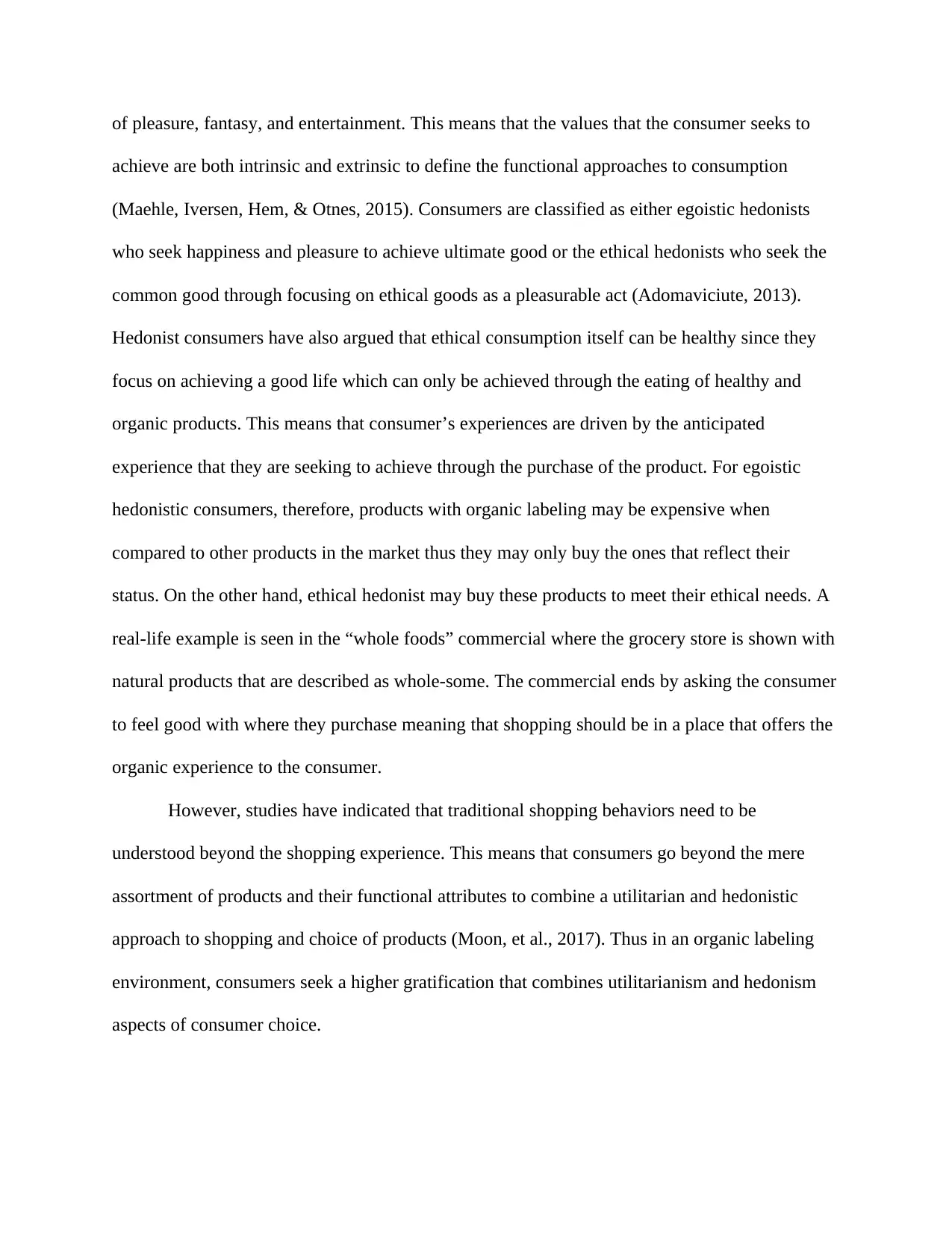
of pleasure, fantasy, and entertainment. This means that the values that the consumer seeks to
achieve are both intrinsic and extrinsic to define the functional approaches to consumption
(Maehle, Iversen, Hem, & Otnes, 2015). Consumers are classified as either egoistic hedonists
who seek happiness and pleasure to achieve ultimate good or the ethical hedonists who seek the
common good through focusing on ethical goods as a pleasurable act (Adomaviciute, 2013).
Hedonist consumers have also argued that ethical consumption itself can be healthy since they
focus on achieving a good life which can only be achieved through the eating of healthy and
organic products. This means that consumer’s experiences are driven by the anticipated
experience that they are seeking to achieve through the purchase of the product. For egoistic
hedonistic consumers, therefore, products with organic labeling may be expensive when
compared to other products in the market thus they may only buy the ones that reflect their
status. On the other hand, ethical hedonist may buy these products to meet their ethical needs. A
real-life example is seen in the “whole foods” commercial where the grocery store is shown with
natural products that are described as whole-some. The commercial ends by asking the consumer
to feel good with where they purchase meaning that shopping should be in a place that offers the
organic experience to the consumer.
However, studies have indicated that traditional shopping behaviors need to be
understood beyond the shopping experience. This means that consumers go beyond the mere
assortment of products and their functional attributes to combine a utilitarian and hedonistic
approach to shopping and choice of products (Moon, et al., 2017). Thus in an organic labeling
environment, consumers seek a higher gratification that combines utilitarianism and hedonism
aspects of consumer choice.
achieve are both intrinsic and extrinsic to define the functional approaches to consumption
(Maehle, Iversen, Hem, & Otnes, 2015). Consumers are classified as either egoistic hedonists
who seek happiness and pleasure to achieve ultimate good or the ethical hedonists who seek the
common good through focusing on ethical goods as a pleasurable act (Adomaviciute, 2013).
Hedonist consumers have also argued that ethical consumption itself can be healthy since they
focus on achieving a good life which can only be achieved through the eating of healthy and
organic products. This means that consumer’s experiences are driven by the anticipated
experience that they are seeking to achieve through the purchase of the product. For egoistic
hedonistic consumers, therefore, products with organic labeling may be expensive when
compared to other products in the market thus they may only buy the ones that reflect their
status. On the other hand, ethical hedonist may buy these products to meet their ethical needs. A
real-life example is seen in the “whole foods” commercial where the grocery store is shown with
natural products that are described as whole-some. The commercial ends by asking the consumer
to feel good with where they purchase meaning that shopping should be in a place that offers the
organic experience to the consumer.
However, studies have indicated that traditional shopping behaviors need to be
understood beyond the shopping experience. This means that consumers go beyond the mere
assortment of products and their functional attributes to combine a utilitarian and hedonistic
approach to shopping and choice of products (Moon, et al., 2017). Thus in an organic labeling
environment, consumers seek a higher gratification that combines utilitarianism and hedonism
aspects of consumer choice.
⊘ This is a preview!⊘
Do you want full access?
Subscribe today to unlock all pages.

Trusted by 1+ million students worldwide

Paraphrase This Document
Need a fresh take? Get an instant paraphrase of this document with our AI Paraphraser
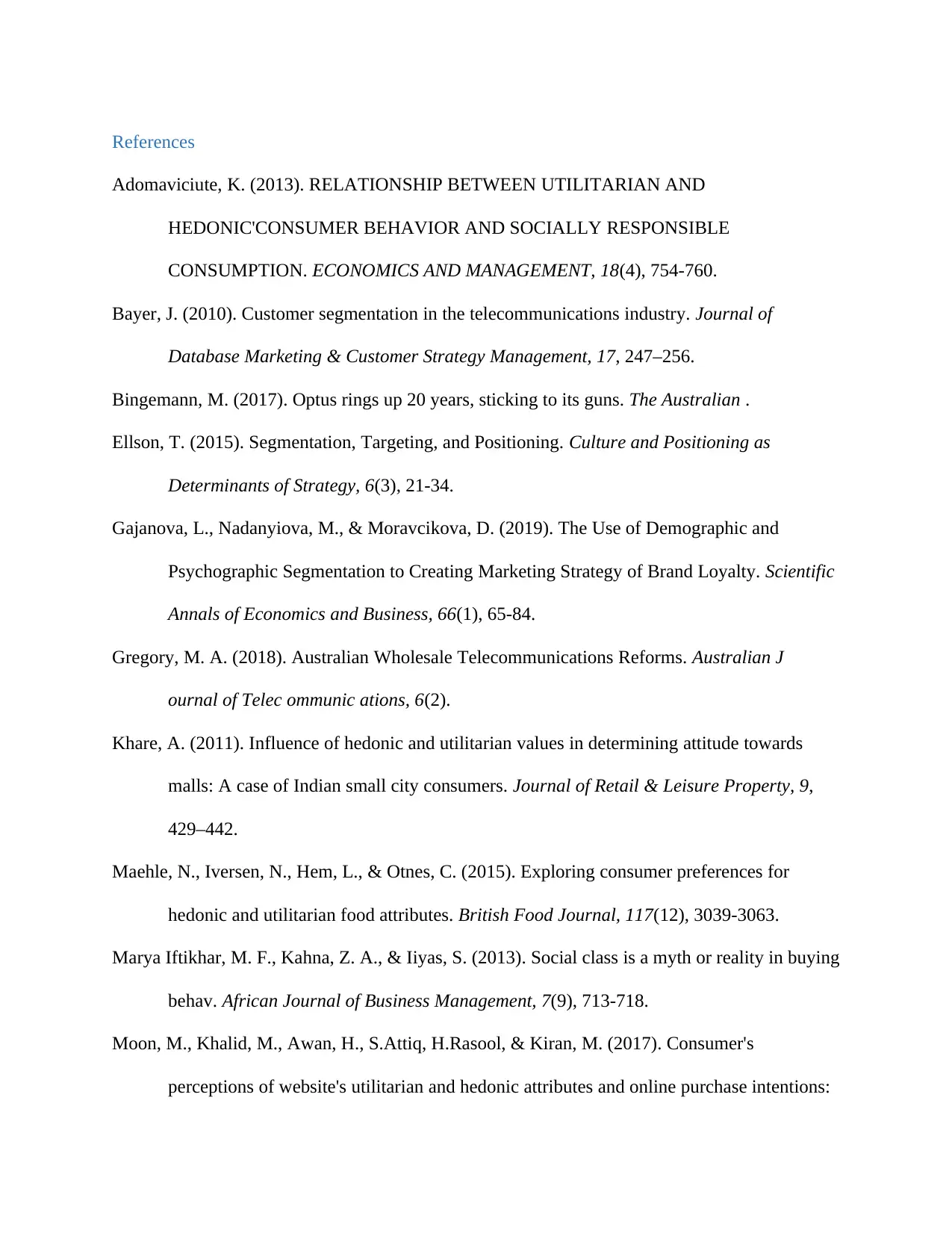
References
Adomaviciute, K. (2013). RELATIONSHIP BETWEEN UTILITARIAN AND
HEDONIC'CONSUMER BEHAVIOR AND SOCIALLY RESPONSIBLE
CONSUMPTION. ECONOMICS AND MANAGEMENT, 18(4), 754-760.
Bayer, J. (2010). Customer segmentation in the telecommunications industry. Journal of
Database Marketing & Customer Strategy Management, 17, 247–256.
Bingemann, M. (2017). Optus rings up 20 years, sticking to its guns. The Australian .
Ellson, T. (2015). Segmentation, Targeting, and Positioning. Culture and Positioning as
Determinants of Strategy, 6(3), 21-34.
Gajanova, L., Nadanyiova, M., & Moravcikova, D. (2019). The Use of Demographic and
Psychographic Segmentation to Creating Marketing Strategy of Brand Loyalty. Scientific
Annals of Economics and Business, 66(1), 65-84.
Gregory, M. A. (2018). Australian Wholesale Telecommunications Reforms. Australian J
ournal of Telec ommunic ations, 6(2).
Khare, A. (2011). Influence of hedonic and utilitarian values in determining attitude towards
malls: A case of Indian small city consumers. Journal of Retail & Leisure Property, 9,
429–442.
Maehle, N., Iversen, N., Hem, L., & Otnes, C. (2015). Exploring consumer preferences for
hedonic and utilitarian food attributes. British Food Journal, 117(12), 3039-3063.
Marya Iftikhar, M. F., Kahna, Z. A., & Iiyas, S. (2013). Social class is a myth or reality in buying
behav. African Journal of Business Management, 7(9), 713-718.
Moon, M., Khalid, M., Awan, H., S.Attiq, H.Rasool, & Kiran, M. (2017). Consumer's
perceptions of website's utilitarian and hedonic attributes and online purchase intentions:
Adomaviciute, K. (2013). RELATIONSHIP BETWEEN UTILITARIAN AND
HEDONIC'CONSUMER BEHAVIOR AND SOCIALLY RESPONSIBLE
CONSUMPTION. ECONOMICS AND MANAGEMENT, 18(4), 754-760.
Bayer, J. (2010). Customer segmentation in the telecommunications industry. Journal of
Database Marketing & Customer Strategy Management, 17, 247–256.
Bingemann, M. (2017). Optus rings up 20 years, sticking to its guns. The Australian .
Ellson, T. (2015). Segmentation, Targeting, and Positioning. Culture and Positioning as
Determinants of Strategy, 6(3), 21-34.
Gajanova, L., Nadanyiova, M., & Moravcikova, D. (2019). The Use of Demographic and
Psychographic Segmentation to Creating Marketing Strategy of Brand Loyalty. Scientific
Annals of Economics and Business, 66(1), 65-84.
Gregory, M. A. (2018). Australian Wholesale Telecommunications Reforms. Australian J
ournal of Telec ommunic ations, 6(2).
Khare, A. (2011). Influence of hedonic and utilitarian values in determining attitude towards
malls: A case of Indian small city consumers. Journal of Retail & Leisure Property, 9,
429–442.
Maehle, N., Iversen, N., Hem, L., & Otnes, C. (2015). Exploring consumer preferences for
hedonic and utilitarian food attributes. British Food Journal, 117(12), 3039-3063.
Marya Iftikhar, M. F., Kahna, Z. A., & Iiyas, S. (2013). Social class is a myth or reality in buying
behav. African Journal of Business Management, 7(9), 713-718.
Moon, M., Khalid, M., Awan, H., S.Attiq, H.Rasool, & Kiran, M. (2017). Consumer's
perceptions of website's utilitarian and hedonic attributes and online purchase intentions:
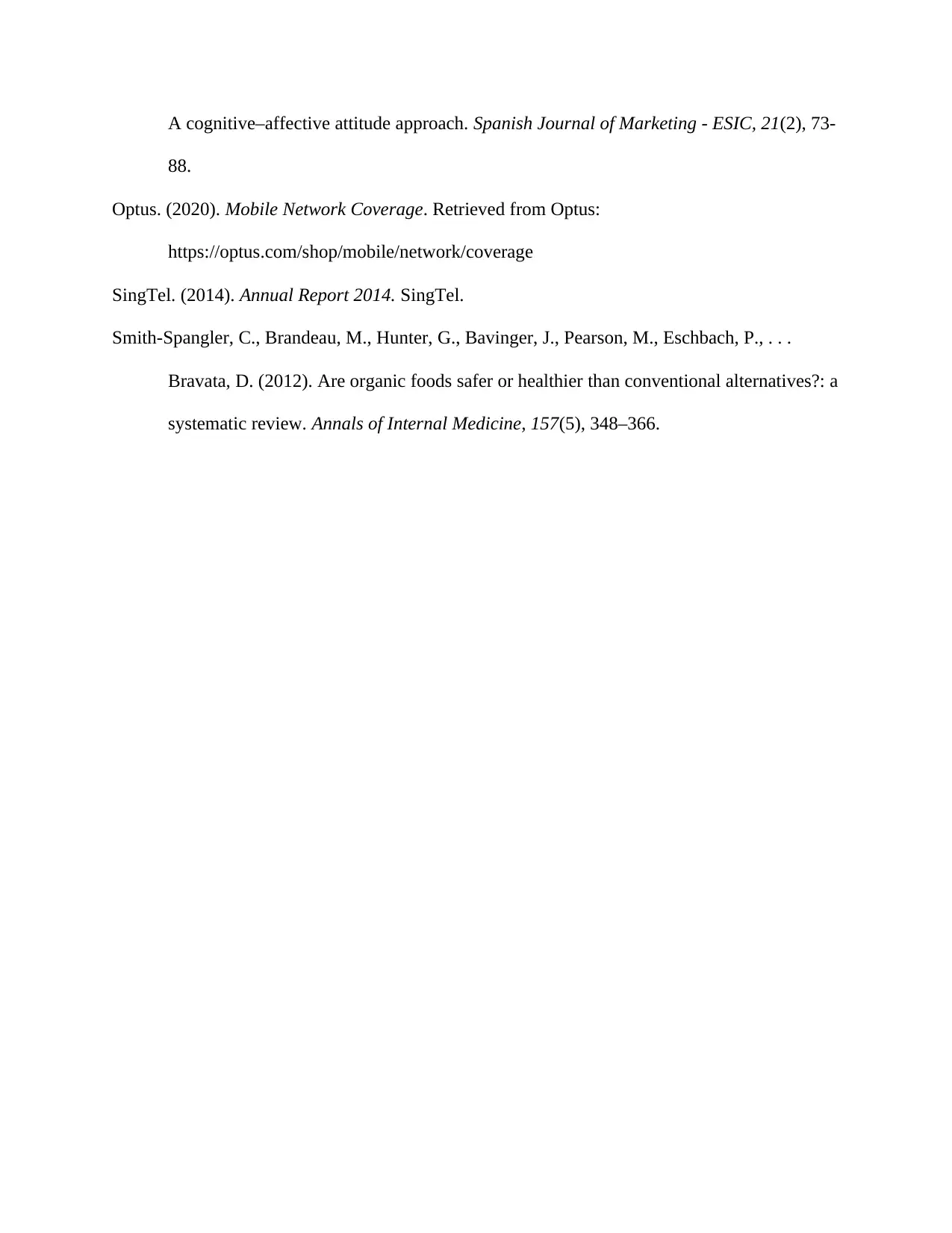
A cognitive–affective attitude approach. Spanish Journal of Marketing - ESIC, 21(2), 73-
88.
Optus. (2020). Mobile Network Coverage. Retrieved from Optus:
https://optus.com/shop/mobile/network/coverage
SingTel. (2014). Annual Report 2014. SingTel.
Smith-Spangler, C., Brandeau, M., Hunter, G., Bavinger, J., Pearson, M., Eschbach, P., . . .
Bravata, D. (2012). Are organic foods safer or healthier than conventional alternatives?: a
systematic review. Annals of Internal Medicine, 157(5), 348–366.
88.
Optus. (2020). Mobile Network Coverage. Retrieved from Optus:
https://optus.com/shop/mobile/network/coverage
SingTel. (2014). Annual Report 2014. SingTel.
Smith-Spangler, C., Brandeau, M., Hunter, G., Bavinger, J., Pearson, M., Eschbach, P., . . .
Bravata, D. (2012). Are organic foods safer or healthier than conventional alternatives?: a
systematic review. Annals of Internal Medicine, 157(5), 348–366.
⊘ This is a preview!⊘
Do you want full access?
Subscribe today to unlock all pages.

Trusted by 1+ million students worldwide
1 out of 12
Related Documents
Your All-in-One AI-Powered Toolkit for Academic Success.
+13062052269
info@desklib.com
Available 24*7 on WhatsApp / Email
![[object Object]](/_next/static/media/star-bottom.7253800d.svg)
Unlock your academic potential
Copyright © 2020–2025 A2Z Services. All Rights Reserved. Developed and managed by ZUCOL.





